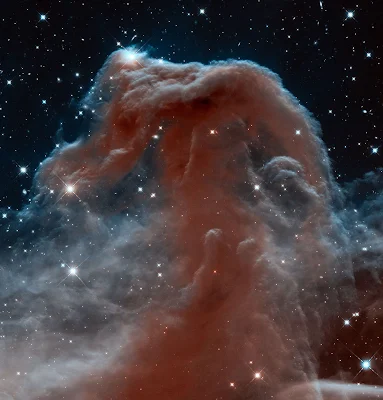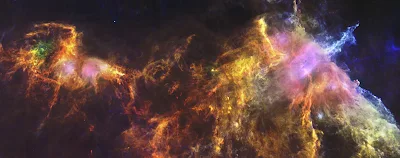Η
Κεφαλή του Αλόγου στην απεικόνιση του τηλεσκοπίου Hubble. This new
Hubble image, captured and released to celebrate the telescope’s 23rd year in
orbit, shows part of the sky in the constellation of Orion (The Hunter). Rising
like a giant seahorse from turbulent waves of dust and gas is the Horsehead
Nebula, otherwise known as Barnard 33. Image released April 19, 2013. CREDIT:
NASA, ESA, and the Hubble Heritage Team (AURA/STScI)
Νέες
εντυπωσιακές εικόνες του νεφελώματος Κεφαλή του Αλόγου από τα τηλεσκόπια
Herschel και Hubble δόθηκαν στη δημοσιότητα από τον Ευρωπαϊκό Οργανισμό
Διαστήματος (ESA) και τη NASA.
Η
Κεφαλή του Αλόγου στην απεικόνιση του τηλεσκοπίου Herschel. Stunning
new view from ESA’s Herschel space observatory of the iconic Horsehead Nebula
in the context of its surroundings. The image is a composite of the wavelengths
of 70 microns (blue), 160 microns (green) and 250 microns (red), and covers
4.5x1.5 degrees. The image is oriented with northeast towards the left of the
image and southwest towards the right. CREDIT: ESA/Herschel/PACS, SPIRE/N.
Schneider, Ph. André, V. Könyves (CEA Saclay, France) for the “Gould Belt
survey” Key Programme
Το
νεφέλωμα με την χαρακτηριστική εμφάνιση προσελκύει το ενδιαφέρον των
επαγγελματιών αλλά και των ερασιτεχνών αστρονόμων και ειδικά το πανοραμικό
«στιγμιότυπο» του Herschel προσφέρει την λεπτομερέστερη ως τώρα απεικόνισή του.
Η
Κεφαλή του Αλόγου βρίσκεται στον αστερισμό του Ωρίωνα, περίπου 1.300 έτη φωτός
μακριά από εμάς. Το νεφέλωμα, το οποίο «διαγράφει» με σπάνια καθαρότητα το
σχήμα του κεφαλιού ενός αλόγου, αποτελείται από αέρια και πολύ πυκνή
μεσοαστρική σκόνη. Ανήκει στο τεράστιο Σύμπλεγμα Μοριακών Νεφών του Ωρίωνα και
γειτονεύει με το Νεφέλωμα της Φλόγας.
Το
δυο διαστημικά τηλεσκόπια λειτουργούν με διαφορετικό τρόπο, γι’ αυτό και
προσφέρουν διαφορετικές απόψεις του νεφελώματος. Το Hublble (NASA/ESA), το
οποίο επέστρεψε στην Κεφαλή του Αλόγου γιορτάζοντας τα 23 χρόνια του σε τροχιά,
δείχνει μια «νεφελώδη» άποψή του απαθανατίζοντάς το στο εγγύς υπέρυθρο φως.
Herschel is one of
the largest space telescopes ever launched; its 3.5m diameter mirror perfectly
captures infrared light. Infrared shines through gas and dust clouds that can
block visible light - Herschel can see deep into dusty star-forming regions.
The telescope is named after the astronomer William Herschel who discovered
infrared radiation while studying the Sun in 1800. The Earth's atmosphere absorbs
infrared, so Herschel was launched into space in 2009 to get a clear view of
the infrared Universe.
Από
την πλευρά του το Herschel (ESA) «βλέπει» στα μεγάλα μήκη της υπέρυθρης
ακτινοβολίας διαπερνώντας τη σκόνη συλλαμβάνοντας τη λάμψη των νεογέννητων
άστρων που υπάρχουν πίσω της. Στο αριστερό τμήμα της απεικόνισης διακρίνονται
τα «μαιευτήρια» άστρων NGC 2068 και NGC 2071.




Δεν υπάρχουν σχόλια:
Δημοσίευση σχολίου